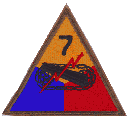|
At this point, I am gathering all the references to specific units at specific locations at specific times and plotting them on the map. Rather than start with any prior marked up map, I am going to start with an unmarked map of the area and systematically go through all the reports to mark up the map. This initial effort will place locations on the map without regard to time. I will add the dimension of time later, probably by using multiple maps. I am also including the post-war map made by German Gen. Otto Remer, commander of the Fuehrer-Begleit Brigade, showing his surprise attack from the northwest when the Americans thought he would come from the east. This is in MS # B-592 of the manuscripts of post-war interviews and accounts by German commanders of their combat actions during the war, compiled and published by the U.S. Army Historical Division in their Foreign Military Studies (FMS) program.
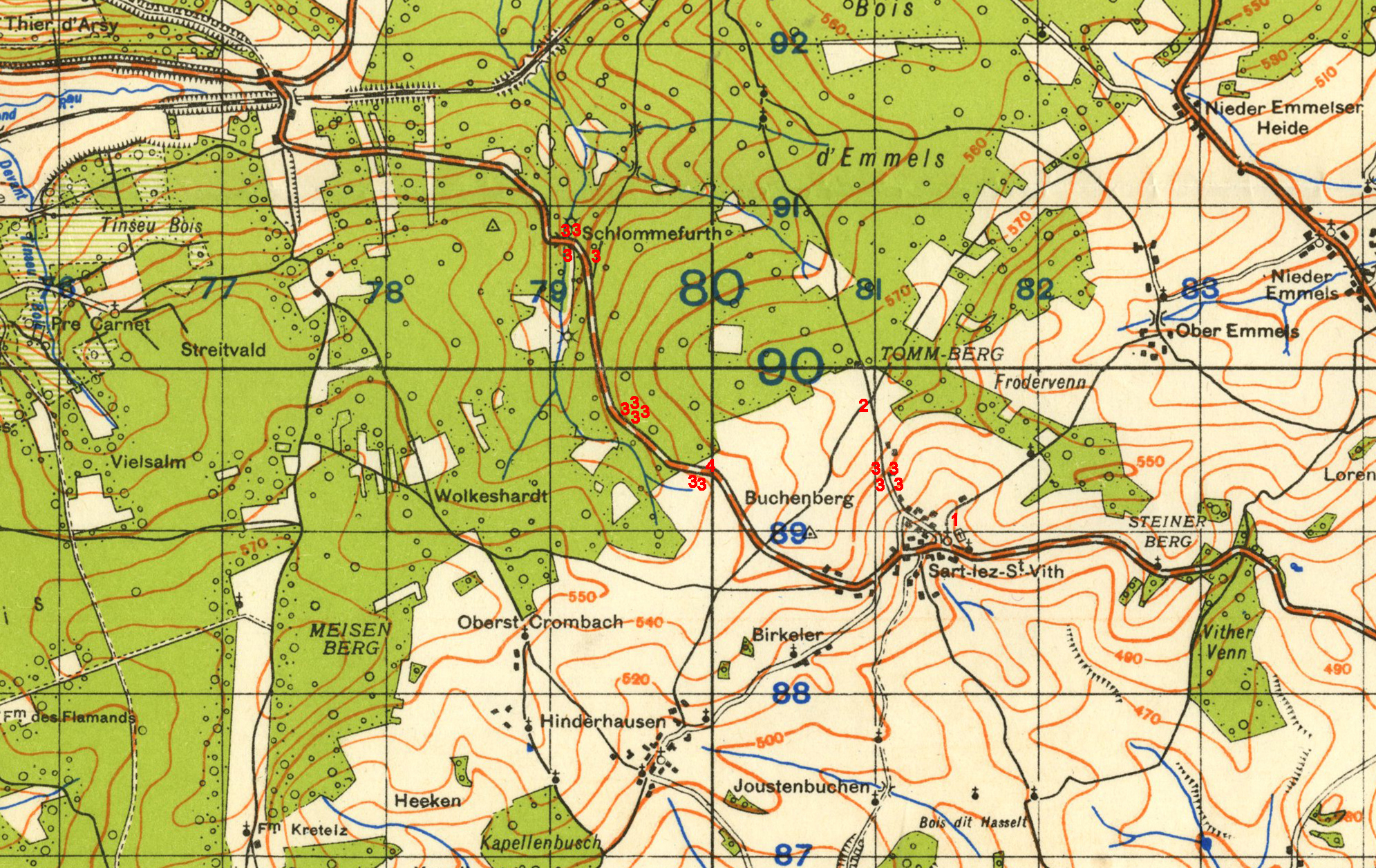
Click on map for full size.
|

Post-war Map by German Gen. Remer of his attack
Red box indicates area of map to the left
Click on image for full size.
|
It is critically important to keep in mind that the Americans did not realize what German Gen. Remer was doing and were taken completely by surprise. They expected him to attack from the east. So, their defenses were oriented that way, and the areas in the woods between Poteau and Rodt/Sart-lez-St. Vith were considered to be safe rear areas. That is why the CCA Tactical Headquarters was located where it was (at Schlommerfurth) and why 40th Tank Battalion's medical aid station was where it was so that the Germans coming out of the woods and cutting the road at 804-889 cut the troops at Rodt off from the route to the aid station. The reality was that the woods were where Gen. Remer's main force was advancing so that all these supposedly safe "rear" areas were in fact taking the brunt of the German advance.
Legend
- Reference 1
- Map Coordinates: 815-891
- Unit: A/40th Tank Battalion Lt. Borchers' platoon (Sgt. Link's tank)
- Date and Time of Action: 22 Dec 1944 by 1300 (per 40th Tank Battalion After Action Report - see reference 2)
- Source: Individual Deceased Personnel File of Frank Aldrich (PDF pp 18-19, 24)
- Specifics: "Body [Unknown X-89 Hamm] was one of 24 Americans brought to cemetery by Sgt. Ward French, 37544950, of 3042nd QM G. R. Co. Hq Platoon at Bastogne, Belgium. According to a check sheet accompanying body, this body was an unknown and in the same grave with Ernest A. Link, 37032105. Across from this common grave was a knocked out U. S. Tank bearing following markings: US Tank 7 No 40, USA 30100330."
Recovery Location: ong road in Sart lez St. Vith Belgium. P815891 Central Europe BONN 1L00000 S-1"
- Observations: Conclusion from "Five A/40 Tank Deaths Reported KIA 23 Dec 1944 but actually KIA 22 Dec": "The five men who were killed were in the lost tank of 2nd Lt. Borchers' platoon of A/40, which bore the number 30100330. The tank was located about 200 yards northwest of the town of Rodt, at map coordinates 815-891. The men were killed when the German Führer Begleit Brigade launched a “broad front” attack from the woods to the north of the A/40 tanks north of Rodt, Belgium and moved on to take the town. It is also clear that this happened on 22 December 1944 and not 23 December 1944
(which was the date as of which the men were later retroactively listed as Missing in Action).
The five men were:
- Cpl. Frank Aldrich (31 447 982) of Washington County, RI - gunner
- Pvt. Qulles V. Bissell (35 926 915) of Summit County, OH - gunner
- Pvt. Raymond C. Hennigan (32 840 204) of Erie County, NY - cannoneer
- Tec 4 Louie A. Johnson (34 272 646) of Orleans Parish, LA - driver
- S/Sgt. Ernest A. Link (37 032 105) of Wilkin County, MN - tank commander
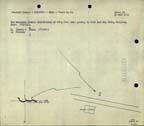
Click on map for full size.
|

Possible Location
Click on image for full size.
|
- Reference 2
- Map Coordinates: 808-897
- Unit: A/40th Tank Battalion Lt. Borchers' platoon
- Date and Time of Action: 22 Dec 1944 0930 - "Lieutenant BORCHER'S platoon could not be contacted by radio after 1300."
- Source: 40th Tank Battalion After Action Report
- Specifics: 0930 Lieutenant BORCHERS of Company A, who had his platoon on a road block at (809897), reported a strong infantry attack. About the same time, tanks and infantry were reported attacking the half-tracks of Company B, 48th Armored Infantry Battalion, in the town of [RODT]. Lieutenant RIDER'S platoon, Company B, 40th Tank Battalion, was dispatched to help protect the vehicles. He reported seven enemy tanks moving toward the village. Company A sent Lieutenant FIELDER'S platoon to help, and later the Assault Gun Platoon was ordered out of its indirect fire position to lend assistance. At 1100, the medical detachment reported they could not flee toward the Battalion
Headquarters because they would come under direct fire. Our tanks took the offensive and the enemy tanks pulled back. Then the medical aid station was able to escape. Lieutenant BORCHER'S platoon could not be contacted by radio after 1300."
"To their credit, they did provide sufficient defense against the surprising direction of the German attack, so that the defenders to the north could withdraw to Hinderhausen."
- Observations:It would appear that Lt. Borchers pulled his platoon from the road block (reference 2) south into Rodt (reference 1) where Sgt. Link's tank was knocked out and all members of the crew killed. It also seems from the broader After Action Report that elements of A/40 were at Poteau to the north so that it appears that the different platoons of A/40 became separated when the Germans attacked.
- Reference 3
- Map Coordinates: Four positions along roads N of Rodt, locations estimated from hand-drawn map overlay
- Unit: A/40th Tank Battalion and CCA Tactical Headquarters
- Date and Time of Action: 18-21 Dec 1944
- Source: 1 Feb 1945 Map Overlay "CCA Positions of A/40 Tanks 18-21 Dec / Lt. Fiedler / 1 Feb. 45" in Combat Interview of 1st Lt. Harold I. Fiedler
- Specifics: Tank positions
- On west road from N to S:
- marked "CCA Hq" - 4 tanks in 2 pairs (pair 1: 1 on west side of road aiming NW, 1 on east side of road aiming SE -- pair 2: both on east side of road with 1 aimed N along road and one aimed ENE)
- marked "Lt Fiedler" - 4 tanks, or 3 tanks and one smaller gun, in 2 pairs all on east side of road (north pair aiming N along road - one may be a smaller gun and not a tank -- south pair aimed S along road)
- 2 tanks on S side of road, both aimed S along the road and marked "These two tanks were on block with other tanks of Lt. Fiedler but were detached and sent to this posn 20th. These are tanks which fired at en patrol & freed prisoners."
- On road just north of Rodt: marked "Lt Borchers' platoon" - 4 tanks in 2 pairs with each pair having one tank on each side of road (north pair aiming N along road and NW, south aiming NW and E)
- Observations:The position of CCA Tactical Headquarters is especially significant. Anticipating the Germans coming from the east, the HQ was put in what was considered a relatively safe wooded position between Rodt and Poteau. But the Fuehrer Begleit Brigage (Gen. Remer) moved through the woods north of Rodt and then attacked down the western road toward Rodt while another armored element of Remer's command attacked west toward Rodt from Ober Emmels (the expected route of German attack). Thus the CCA Tactical Headquarters took the first brunt of Remer's western attack.
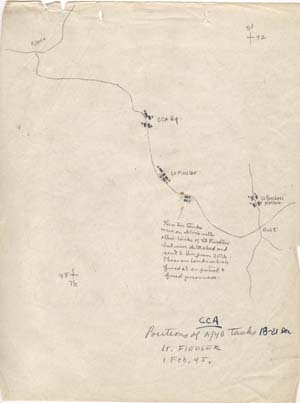
Click on map for full size.
- Reference 4
- Map Coordinates: "edge of the woods at 800894"
- Unit: platoon of three tanks of B/40th Tank Battalion (20 or 21 Dec) AND 40th Tank Battalion Assault Guns (22 Dec)
- Date and Time of Action: 20 or 21 Dec 1944 AND 22 Dec 1944
- Source: 3 Jan 1945 Combat Interview of Capt. Emerson Wolfe, CO B/40 and map of B/40 positions
- Specifics: "20 or 21 December A platoon of three tanks was sent to outpost in the edge of the woods at 800894 after a number of peeps and their occupants had been lost thru german infiltration of the woods to that
point.
22 December Company moved to immediate W of RODT at the time of the enemy attack on that town. A/40 was to the left of the road to fire into the town, and B/40 was to the right of the road to tie in with CCB units to the S of town. The Bn AG’s, under control of Captain Wolfe, were dispatched to firing positions along the edge of the woods 800894.
A fire fight was carried on with german armored vehicles moving into RODT, but no hits were observed. One B/40 tank was hit.
That night the B/40 tanks were withdrawn to vic PETIT THEIR."
- Observations:none at this time
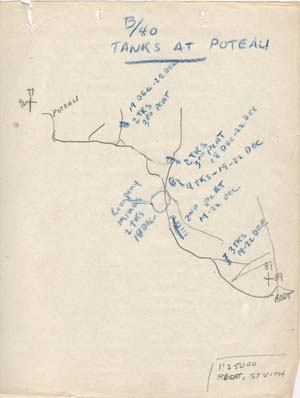
Click on map for full size.
- Reference 5
- Map Coordinates: line from about 818896 to about 829895, plus withdrawal route to Hinderhausen
- Unit: A/17 and 1/C/38 (1st platoon) and C/38 halftracks
- Date and Time of Action: 21 Dec 1944 AND 22 Dec 1944
- Source: 1 Jan 1945 Combat Interview of 2nd Lt. Walter M. Schonour (CO 1/C/38) and map of positions
- Specifics:
"
Friday, 22 Dec In the morning I inspected the lines which were in very good shape. We made a couple of adjustments on the left flank to tie in more closely with the 23rd.
Between 0900 and 1000, the CO of A/17 received a report that the positions we were holding were untenable and that we were to withdraw to the other side of Rodt for Ober Emmels, and this the only road the tracks could use. Word
was sent to the right flank to withdraw to the tracks in the rear of the cleared space. They got about half the way in when the left flank units began to come in with the news that the enemy had broken through the 23rd positions, and that enemy tanks had come up and were firing at the six tracks and cutting the only road.
The tracks had to be abandoned. The infantry had to hang on to the A Company tanks which went down through a fire break and circled the town of Rodt while under constant fire. The infantry on the tanks fired constantly to
keep enemy small arms fire down to a minimum. (Lt. Schonover has the highest praise for the way in which Lt Wilson of the 17th managed the withdrawal and credits him with saving both tanks and infantry.
The hardest fighting was east of Rodt (see map) where at least two of the tanks were hit. The infantry had to get out as best they could. They went from tank to tank. There were light tanks in the line, and when a marsh was
reached, they couldn't get through the soft ground and had to be abandoned. Some vehicles belonging to other units also had to be abandoned.
The column circled Rodt and went on to Hinderhausen. Every man of the 38th was gotten out safely, although equipment losses were heavy. Men lost their weapons and some of their clothing. They had to go as light as possible.
At Hinderhausen, 17th tanks outposted the town. The men of the 38th were pretty well split up, but most of them were rounded up and again were split into impromptu squads to outpost the tanks. In this way, four medium tanks of
A/17 were outposted. Stragglers from other outfits were rounded up and helped out. We had about 70 men in all. Friday night was spent there.
"
- Observations:Despite the statement that every 28AIB man got out safely, C/38 veteran Ed Burke was in the line and in the withdrawal told me that about 15 American tanks had pulled back to the C/38 position (apparently NOT the 1st Platoon position since Ed recalls being right at the road junction just north of Rodt, on high ground above Rodt - so definitely not the 1/C/38 position that was further east) at that point and were only 5 feet away from the C/38 men, who mounted the tanks which pulled back down the hill towards Rodt and then turned right to Hinderhausen. The tanks had to drive over the fields between the two towns, since the Germans had the road zeroed in. The 38 AIB Combat Interview, Ed Burke noted to me, stated that there were no 38 AIB casualties in this action, but Ed said that he knew of one C/38 man whose head was blown off and another who he saw laying on his back in the snow with what was left of one of his legs sticking up in the air, with the bone fully exposed.
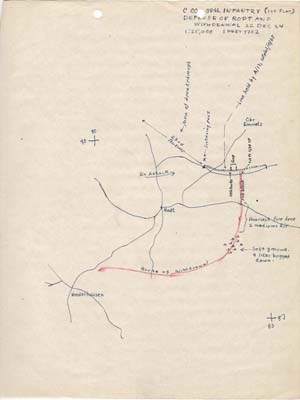
Click on map for full size.
- Reference 6
- Map Coordinates: remains recovered from 803-888 (mention of German patrol cutting road at 804-889) which is at about 50.286846, 6.054885; remains left in house at 795-900
- Unit: Headquarters/Combat Command A; 2 men of 48th Armored Infantry Battalion
- Date and Time of Action: 21 Dec 1944
- Source: Individual Deceased Personnel File of 1st Lt. Daniel J. Murphy and Statement of HQ/CCA veteran John Durba (9 Sep 2001) and 40th Tank Battalion After Action Report
- Specifics: John Durba: "A couple hundred yards up from Poteau, a large group of 70-80 Germans came out of woods and stopped Murphy's peep. Murphy tried to grab the machine gun on the mount and was killed. The rest in peep were captured. The Germans broke up and scattered. Frank Wickerham, one of the men captured, was carrying another wounded GI. Wickerham talked the Germans into giving up at an American outpost. Murphy was possibly 1st Lt, possibly the S-1 officer."
IDPF: Remains of CCA men Daniel Murphy, Jack Fisk, Wilbur Woolbright (Murphy killed in separate action from the other two) were left in a house at 795-900 that had to be abandoned when the Germans overran the position (PDF p 67). At some point, someone moved their remains (later recovered as Henri-Chapelle Unknowns X-455, X-462, X-457 respectively) and the remains of two 48 AIB men (Milton E. Fein HQ Co/48, Lawrence D. Smith A/48) to 803-888 where they were buried and later (12 Mar 1945) recovered.
40 Tank Bn After Action Report Dec 44 (p. 8): 21 Dec 44 "At 1130 a strong enemy patrol was reported to have cut the road (at 804889) between our medical aid station at SARTLEX ST VITH and "CCA" tactical headquarters (at 792908). A platoon from Company B, 40th Tank Battalion was dispatched to clean it out. Three ¼ ton trucks and a light tank were found on the road, disabled by bazooka and small arms. Further investigation disclosed eight more ¼ ton trucks on a side road on the north side of the main highway. One officer of "CCA" was found dead. Missing were a score of men and four officers, none of whom were from this Battalion."
- Observations: There is something about this that does not make sense. The location where Daniel Murphy was killed and later buried is virtually the same place. But the 23 Apr 1945 identification memorandum paragraph 2b states (without giving any source) that the three CCA men killed 21 Dec 1944 were removed from where they were killed and "left in a house near Poteau, Belgium, (Map Coordinates P 795900), when that organization was forced to evacuate the area." So, it seems highly unusual that the remains of the three men would then be taken by the Germans (burial by the Germans is confirmed in the IDPF of Jack Fisk) to be buried at almost the same place where Daniel Murphy had been killed. The two "6" entries on the map at the top of this web page show the location of the house at 795-900 and the location of the place he was killed and also buried.
They were recovered by US Graves Registration 12 Mar 1945 from 803-888 which is almost the same place where the German patrol cut the road at 804-889 which is the same coordinates where the B/40 response platoon found Murphy's remains as well as many destroyed vehicles. And the IDPF of Jack Fisk has a German record that shows they buried the GIs in grave 9 of a soldiers' cemetery next to the "Forsthaus" (translated as forest rangers house). So, it does seem that the Germans either chose to use the site as a military cemetery or else found a cemetery already there and used it for more burials. That would explain the concentration of GI burials there. And if the Germans chose that spot because it was where so many US vehicles were destroyed, then it would make sense as well. We may never really know.
A search of Google Maps shows there is now a house at 803-888 or at least at the road junction. There is no sign of a cemetery. But at the stated location of a house (795-900) there is nothing now but solid forest. The statement about the coordinates of the house exists only in the identification letters which give no source for it, and the IDPFs of the three men contain no other reference to those coordinates other than the identification memoranda. So, the credibility of those coordinates is suspect. Could the house have been the one that is now standing at 803-888? The WWII grid map does show small black boxes for buildings, but it show no black box for a building at either location.
It is critically important to keep in mind that the Americans did not realize what German Gen. Remer was doing and were taken completely by surprise. They expected him to attack from the east. So, their defenses were oriented that way, and the areas in the woods between Poteau and Rodt/Sart-lez-St. Vith were considered to be safe rear areas. That is why the CCA Tactical Headquarters was located where it was (at Schlommerfurth) and why 40th Tank Battalion's medical aid station was where it was so that the Germans coming out of the woods and cutting the road at 804-889 cut the troops at Rodt off from the route to the aid station. The reality was that the woods were where Gen. Remer's main force was advancing so that all these supposedly safe "rear" areas were in fact taking the brunt of the German advance.
- Reference 7 (see also references 8-10 at same location)
- Map Coordinates: side references to Feckelsborn and Poteau
- Unit: B/48 & side references to C/48 and 290 Inf Rgt/75ID
- Date and Time of Action: side references to 23 Dec 1944 and 18 Jan 1945
- Source: Individual Deceased Personnel File of Pfc. Andrew J. Baziow
- Specifics: Graves Registration searched for Baziow at Poteau when the records seem to indicate he was possibly actually SSE where B/48 had their vehicles parked. Thus the IDPF sheds no light on Baziow but does have side references to two unrelated men. I think there is a good possibility that Baziow's remains were among the multiple remains turned over to the Germans who loaned them back to the Americans post-war and from which Bailey was identified before the other remains were again turned over to the Germans with no apparent attempt to identify any of them as American when in fact they might all be American since an X-tag was found among them.
- (PDF p 9) Resident of Poteau Mr. Henri found dog tag of Berkley H. Inge on same spot where Americans evacuated remains several months earlier. Pvt. Inge was a member of the 290th Infantry Regiment of 75th Infantry Division, killed 18 Jan 1945. So the site was apparently also a combat site in Jan 1945 after the Germans had taken the area in Dec 1944 and then were driven back in Jan 1945.
- (PDF p 60) 11 Mar 1947 letter from Hugo Henri: "... we found two identity tags (belonging to an American soldier) in a shed, a few months after the Americans had evacuated the body... BERKLEY H. INGE, 33 821 309 T 44 44 O." He also references a paper shown to him asking about Baziow and about Pvt. Hayward R. Bolyard. Bolyard was in C/48 with last day of duty 23 Dec 1944 when C/48 "Withdrew fr Poteau, Belgium and moved to an assembly area at [Harze]" with the starting location shown on the Morning Report as Petit-Thier and not Poteau. Bolyard was apparently wounded and captured and taken by the Germans to an area near Feckelsborn where civilian Joseph Mettler later found Bolyard's remains unburied under a tree in the woods behind his house in May 1945 and buried Bolyard at that location.
- Observations: Although his file gives no specific location for Baziow, the fact that the 75th Infantry Division lost a man in Poteau in January 1945 provides awareness that there was combat in the area again in mid January 1945.
- Reference 8 (same location as 7; so no number 8 added to map)
- Map Coordinates: "500 yds. North of Sart Leg St. Vith [Rodt]" - thus near position 7 at Poteau
- Unit: 1st Squad of Anti-Tank Platoon (acting as infantry) of B/48
- Date and Time of Action: 22 Dec 1944
- Source: Individual Deceased Personnel File of Pfc. Joe Wilson Bailey
- Specifics: (PDF p 128) "was with his squad protecting a road block from enemy attack. We had repelled several attacks by the enemy. The enemy then laid a mortar barrage upon the position of the 1st sqd. of the A. T. Platoon. The order was immediately given for the 1st sqd. to withdraw. When the sqd. had withdrawn Pvt. Bailey was nor present. It is believed that Pvt. Bailey was wounded by the mortar barrage laid on his position."
- Observations: This complex 199-page IDPF is key for Bailey, Baziow and Bryan. It strongly supports the possibility that Baziow and Bryan were among the remains turned back over to the Germans after WWII as German remains when in fact they were GIs. The file is a mixture of accurate and inaccurate information, with much copying and disorder.
The research in the IDPF is flawed: he was reported MIA 24 Dec 1944 by which time B/48 had withdrawn to near Manhay, but he really went missing 22 Dec 1944 when AT/B/48 was near Poteau (acting as infantry) when the Germans overran the area while 7AD withdrew. The Missing Report (PDF p 128) does have a fairly accurate location "500 yds. North of Sart Leg St. Vith [Rodt]" which does fit with the B/48 position at Poteau in reference source 7 above. Baziow (also in B/48, probably in the same 1st squad of the anti-tank platoon fighting as infantry) was most likely at the same location. Bryan (in A/33, engineers fighting as infantry with AT/B/48) was at the same location.
- Reference 9 (same location as 7; so no number 9 added to map)
- Map Coordinates: 742-915 (PDF p 27) - this was probably the battalion headquarters location with the AT/B/48 location further east at 772-915 (Poteau) which is number 7 on the marked map
- Unit: AT/B/48; battalion maintenance and "B" Company vehicles
- Date and Time of Action: 22 Dec 1944
- Source: Individual Deceased Personnel File of Pfc. Andrew J. Baziow
- Specifics: (PDF p 27 48 AIB After Action Report) "Enemy forces attacked the battalion maintenance and "B" Company vehicles which wer in an assembly area near RODT beginning at 0300. Artillery and mortar fire preceded the infantry and tank attack overrunning the A. T. Platoon of "B" Company in the attack. Heavy fighting took place which resulted in the units losing all vehicles and large weapons."
(PDF p 33) "KIA 22 December 1944 at Poteau, Belgium"
He was compared with Neuville X-4014 and X-4015 who were both recovered from the vicinity of Poteau, but both have been identified and were later deaths from other units.
- Observations: This 66-page IDPF says that he was checked against Neuville-en-Condroz Unknowns X-4014 (later identified as Cpl. John P. Young 517th Parachute Infantry Regiment) and X-4015 (later identified as Capt. Jack E. McCutchen 373rd Fighter Group, 410th Fighter Squadron) since they were both recovered in the vicinity of Poteau.
|
